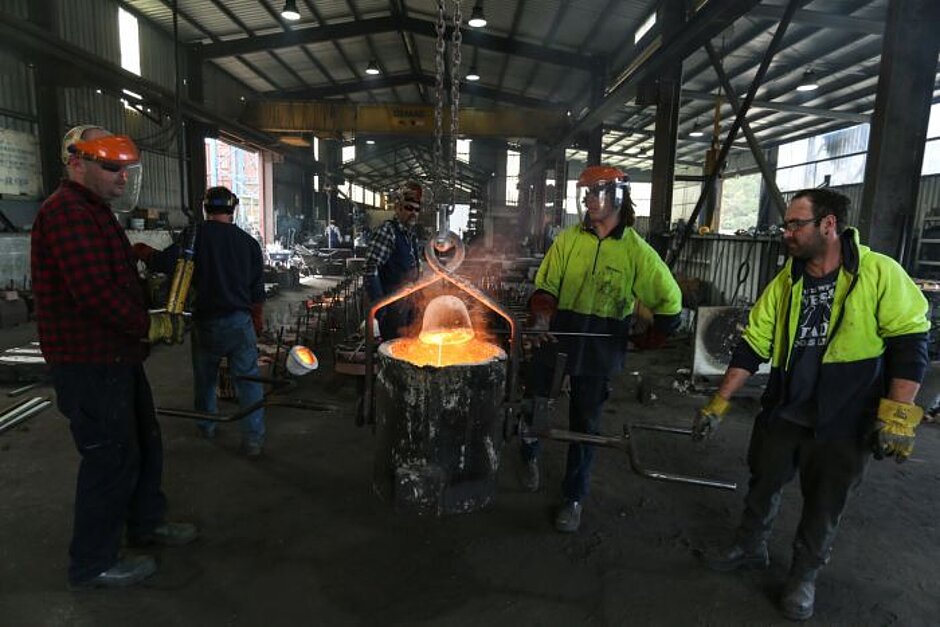Max Billman refers to it as a "hard, dirty game" but for close to 40 years Billman's Foundry in Castlemaine has been producing a range of metal castings, from statues of Melbourne Cup winner Black Caviar to new Singaporean presidential gates, after a tank drove through them.
The foundry is the only Australian company to commercially produce cast iron camp ovens, and the three-generational business specialises in one-off work made from hand-crafted patterns and sand moulds.
Much of their work includes heritage reproductions and restorations for local councils and they produce aluminium, bronze, and cast-iron verandah posts and fountains.
"The ones that they can't go to China and get done," Mr Billman said.
With orders from across the country, he said his wife gets "a bit sick" of having to stop while on the road to admire his work.
"You think, 'Oh, yeah, I made that light post', so you gotta park and go over and have a look and see if the name's on the bottom," Mr Billman said.
Where once there were tens of thousands of businesses capable of casting metal, especially during the boom years of post-war Australia, Victorian president of the Australian Foundry Institute (AFI), David Sykes, estimates only about 100 to 150 businesses remain.
In an era of technological advancements, with robots replacing workers and 3D printing replacing old pattern making skills, Billman's Foundry is one of about 50 smaller, low-volume businesses of its kind that remain in the country.
But even with staff reduced from nearly 20 employees to 12 in the past two years — with most of those left "pushing sixty" — Mr Billman is concerned.
Mr Sykes said the situation for apprentices throughout Australia was problematic, with Queensland being the only state to offer apprenticeships for pattern making and moulding.
He said the AFI was working with the Victorian Government to develop another model of apprentice training following the closure of many Victorian TAFE schools in the late 1990s.
"It's based on training inside the workforce rather than off-the-job training," he said.
When school's not your thing
Just like Mr Billman and his son, who left school at a young age to take on an apprenticeship, and his father before him, so too 17-year-old Justin McKeone left school last year to work at the foundry fulltime.
And like Mr Billman, Justin is a third-generation foundry worker, working alongside his father.
"I decided to leave school because school wasn't really my thing, it just never worked out for me; I was more of a working person," he said.
In school Justin said he was "a bit of a troublemaker" who struggled to concentrate and listen during class.
The young labourer said he enjoyed his work now but would ideally like to be part of an apprenticeship course to gain formal recognition and add to his learning.
"It's a good thing to have in your resume," he said.
His father Jason McKeone, a moulder by trade who now works as a furnaceman, said even if his son went off to pursue other work it would be beneficial to have a formal qualification.
"There's not too many people that can do what we do here," Mr McKeone said.
"There's a lot of knowledge in this place, a lot of old knowledge and someone's got to have it."
Mr McKeone said despite technological advancements leading to robots performing more manufacturing roles, he said it was not an option for his son to stay at school to further his education.
"He's learning here, he's learning a good work ethic with blokes who are really good workers and get along well together," he said.
'Something different all the time'
Malcolm Sturgess has been handmaking sand moulds at Billman's for close to 30 years.
The ex-truck driver and abattoir worker has only ever had three jobs in his lifetime and said this was his favourite.
"It's not the same thing every day — you're doing something different all the time," he said.
He said he enjoyed the challenge of creating intricate sand moulds.
One project, the Daylesford Fountain in central Victoria, took more than two months to create.
"I'd be bored if I was doing the same thing day in day out; I'm still learning now," Mr Sturgess said.
But he refers to it as a dying art compounded by the closure of TAFE schools for apprenticeships.
Time of transition
While technology is replacing sand moulds in many large production foundries, Mr Billman cannot imagine a 3D printer creating large and intricate works.
"It will take a long time before they could get there and print a lamp post or something [as detailed]," he said.
"Foundries have been around since the year dot. They're one of the oldest trades there are, so things will still be done this way for a while."
Mr Sykes said while technology was starting to meet some of the demands of skilled pattern makers and moulders, it was yet to meet all demands.
"The jobbing foundries are reasonably secure nowadays because of the fact that work can't be done elsewhere," he said.
But Mr Sykes said there would have to be some level of technological adaptation.
"It's a cost issue and the availability of technology," he said.
During this "transitional time" he said the traditional pattern making skills could be applied to 3D modelling skills but education was the key.
"Formal trade qualifications will still be needed in the long-term," Mr Sykes said.
Source: www.abc.net.au


